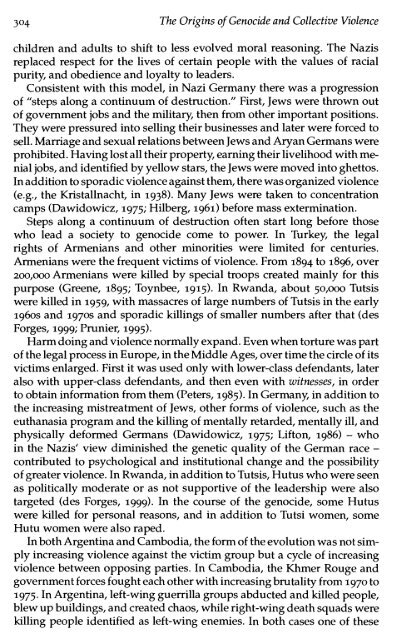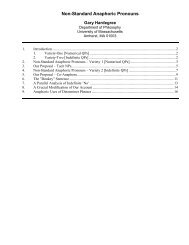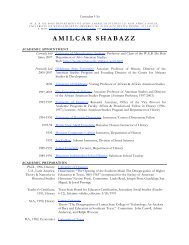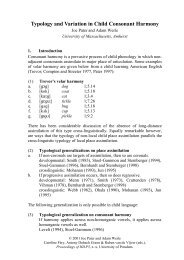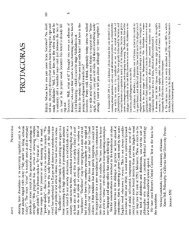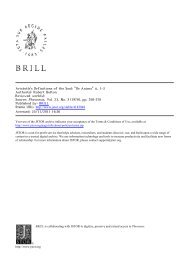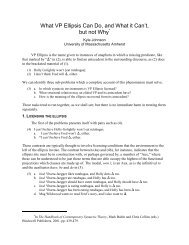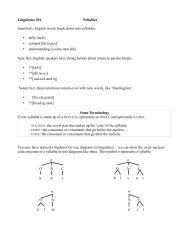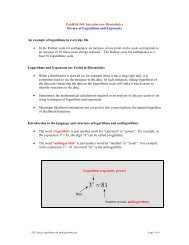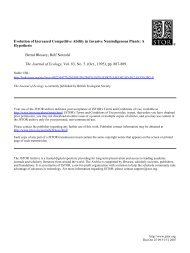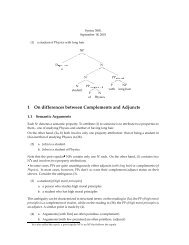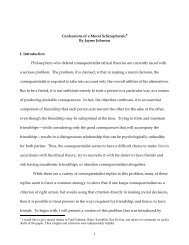The Psychology of Bystanders, Perpetrators, and Heroic Helpers
The Psychology of Bystanders, Perpetrators, and Heroic Helpers
The Psychology of Bystanders, Perpetrators, and Heroic Helpers
Create successful ePaper yourself
Turn your PDF publications into a flip-book with our unique Google optimized e-Paper software.
304 <strong>The</strong> Origins <strong>of</strong> Genocide <strong>and</strong> Collective Violence<br />
children <strong>and</strong> adults to shift to less evolved moral reasoning. <strong>The</strong> Nazis<br />
replaced respect for the lives <strong>of</strong> certain people with the values <strong>of</strong> racial<br />
purity, <strong>and</strong> obedience <strong>and</strong> loyalty to leaders.<br />
Consistent with this model, in Nazi Germany there was a progression<br />
<strong>of</strong> "steps along a continuum <strong>of</strong> destruction." First, Jews were thrown out<br />
<strong>of</strong> government jobs <strong>and</strong> the military, then from other important positions.<br />
<strong>The</strong>y were pressured into selling their businesses <strong>and</strong> later were forced to<br />
sell. Marriage <strong>and</strong> sexual relations between Jews <strong>and</strong> Aryan Germans were<br />
prohibited. Having lost all their property, earning their livelihood with menial<br />
jobs, <strong>and</strong> identified by yellow stars, the Jews were moved into ghettos.<br />
In addition to sporadic violence against them, there was organized violence<br />
(e.g., the Kristallnacht, in 1938). Many Jews were taken to concentration<br />
camps (Dawidowicz, 1975; Hilberg, 1961) before mass extermination.<br />
Steps along a continuum <strong>of</strong> destruction <strong>of</strong>ten start long before those<br />
who lead a society to genocide come to power. In Turkey, the legal<br />
rights <strong>of</strong> Armenians <strong>and</strong> other minorities were limited for centuries.<br />
Armenians were the frequent victims <strong>of</strong> violence. From 1894 to 1896, over<br />
200,000 Armenians were killed by special troops created mainly for this<br />
purpose (Greene, 1895; Toynbee, 1915). In Rw<strong>and</strong>a, about 50,000 Tutsis<br />
were killed in 1959, with massacres <strong>of</strong> large numbers <strong>of</strong> Tutsis in the early<br />
1960s <strong>and</strong> 1970s <strong>and</strong> sporadic killings <strong>of</strong> smaller numbers after that (des<br />
Forges, 1999; Prunier, 1995).<br />
Harm doing <strong>and</strong> violence normally exp<strong>and</strong>. Even when torture was part<br />
<strong>of</strong> the legal process in Europe, in the Middle Ages, over time the circle <strong>of</strong> its<br />
victims enlarged. First it was used only with lower-class defendants, later<br />
also with upper-class defendants, <strong>and</strong> then even with witnesses, in order<br />
to obtain information from them (Peters, 1985). In Germany, in addition to<br />
the increasing mistreatment <strong>of</strong> Jews, other forms <strong>of</strong> violence, such as the<br />
euthanasia program <strong>and</strong> the killing <strong>of</strong> mentally retarded, mentally ill, <strong>and</strong><br />
physically deformed Germans (Dawidowicz, 1975; Lifton, 1986) - who<br />
in the Nazis' view diminished the genetic quality <strong>of</strong> the German race -<br />
contributed to psychological <strong>and</strong> institutional change <strong>and</strong> the possibility<br />
<strong>of</strong> greater violence. In Rw<strong>and</strong>a, in addition to Tutsis, Hutus who were seen<br />
as politically moderate or as not supportive <strong>of</strong> the leadership were also<br />
targeted (des Forges, 1999). In the course <strong>of</strong> the genocide, some Hutus<br />
were killed for personal reasons, <strong>and</strong> in addition to Tutsi women, some<br />
Hutu women were also raped.<br />
In both Argentina <strong>and</strong> Cambodia, the form <strong>of</strong> the evolution was not simply<br />
increasing violence against the victim group but a cycle <strong>of</strong> increasing<br />
violence between opposing parties. In Cambodia, the Khmer Rouge <strong>and</strong><br />
government forces fought each other with increasing brutality from 1970 to<br />
1975. In Argentina, left-wing guerrilla groups abducted <strong>and</strong> killed people,<br />
blew up buildings, <strong>and</strong> created chaos, while right-wing death squads were<br />
killing people identified as left-wing enemies. In both cases one <strong>of</strong> these


